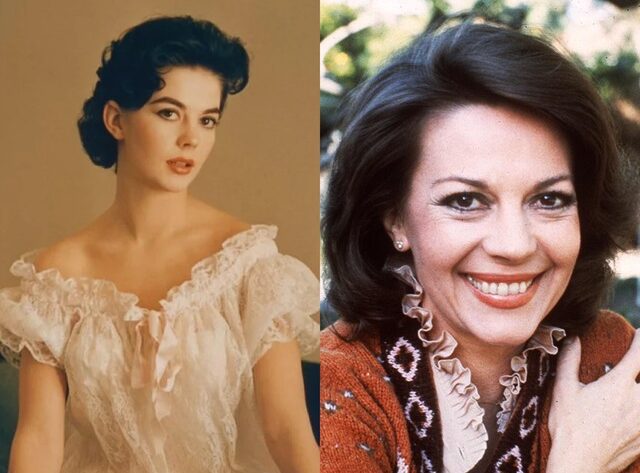Known for her iconic roles in „Rebel Without a Cause“ and „West Side Story,“ Natalie Wood became one of the most celebrated actresses of Hollywood’s Golden Age. Despite her on-screen success, her life was marked by personal struggles and a tragic end that continues to provoke speculation. From her early beginnings in Hollywood to her untimely death, Wood’s journey is a poignant story of fame, heartbreak, and a lasting legacy.
Early Life and Entry into Hollywood
Natalie Wood was born Natalia Nikolaevna Zakharenko on July 20, 1938, in San Francisco to Russian immigrant parents. Her mother, Maria, played a significant role in guiding her towards a career in entertainment. Recognizing her daughter’s talent, Maria introduced her to the performing arts, and by the age of four, Natalie had landed her first role in the film „Happy Land“ (1943).
Her breakthrough came in 1947 with her role in the holiday classic „Miracle on 34th Street,“ where she played a young girl questioning the existence of Santa Claus. This film launched her into the public eye, and she quickly became one of Hollywood’s beloved child stars.

Rise to Stardom
As Natalie Wood transitioned into her teenage years, she proved her acting range, capturing the attention of audiences with her emotional depth. At 16, she starred in „Rebel Without a Cause“ (1955) alongside James Dean and Sal Mineo. Her portrayal of Judy, a troubled teenager searching for love and acceptance, earned her an Academy Award nomination and solidified her place as one of Hollywood’s brightest young stars.
The 1960s marked the peak of Wood’s career. In 1961, she delivered a powerful performance in „Splendor in the Grass,“ a film that explored the pressures of societal expectations and the emotional turmoil of youth. Her portrayal earned her a second Academy Award nomination. That same year, she starred as Maria in the acclaimed film „West Side Story,“ a modern adaptation of „Romeo and Juliet.“ Although her singing was dubbed by Marni Nixon, Wood’s emotive performance in the film made her an enduring figure in cinema history.

Personal Life and Relationships
Off-screen, Natalie Wood’s personal life became as captivating as her film career. Known for her high-profile relationships, she was romantically linked to stars like Dennis Hopper and Elvis Presley during her early years in Hollywood. Her first marriage to actor Robert Wagner in 1957, at the age of 18, was highly publicized, though the couple divorced in 1962. Wood later married writer and producer Richard Gregson in 1969, with whom she had her first daughter, Natasha. However, this marriage also ended in divorce.
In 1972, Wood remarried Wagner, and they had a second daughter, Courtney. Despite the highs of her career, Wood faced significant emotional struggles, including a suicide attempt in 1966. Her resilience was evident as she continued to navigate the complexities of both her professional and personal life.

Later Career
After taking a brief hiatus from acting, Wood returned to the screen in 1969 with the comedy „Bob & Carol & Ted & Alice.“ The film was a success, reaffirming her versatility as an actress. In the mid-1970s, she moved into television, delivering praised performances in the 1976 production of „Cat on a Hot Tin Roof“ and the 1979 miniseries „From Here to Eternity.“
Wood’s later career was marked by a few notable projects, but also some less successful ones, such as the 1979 science-fiction film „Meteor.“ Nonetheless, her performances continued to demonstrate her range and commitment to her craft. Her final film project, „Brainstorm“ (1981), a science-fiction thriller co-starring Christopher Walken, would tragically be her last appearance on screen.

The Tragic End
On November 29, 1981, Natalie Wood’s life was tragically cut short under mysterious circumstances during a boating trip off Catalina Island, California. She had been aboard the yacht „Splendour“ with her husband Robert Wagner and co-star Christopher Walken. The details surrounding her death remain unclear. Her body was discovered floating in the water, and her death was initially ruled as an accidental drowning.
There were inconsistencies in the accounts of that night, with some reports suggesting an argument between Wood and Wagner. Additionally, Wood was known to have a fear of water, which raised further questions about the circumstances leading to her death. In 2011, the Los Angeles County Sheriff’s Department reopened the investigation, naming Wagner as a „person of interest,“ though no charges were filed. The cause of death was later amended from „accidental drowning“ to „drowning and other undetermined factors,“ leaving the case unresolved and shrouded in mystery.

Legacy
Natalie Wood’s legacy lives on as a symbol of both Hollywood’s glamour and the fragility of stardom. Her unforgettable performances in „Rebel Without a Cause“ and „West Side Story“ continue to inspire filmmakers and actors. Wood’s ability to convey complex emotions and her innate connection with audiences set her apart as one of the most influential actresses of her generation.
Beyond her acting career, Wood broke barriers for future generations of actresses, showing that it was possible to take on multifaceted, nuanced roles. Her legacy continues to inspire, as colleagues and fans remember her not only for her on-screen talent but also for her emotional depth and unwavering commitment to her craft.

Conclusion
Natalie Wood’s life, though marked by brilliance, was also fraught with challenges. Her untimely death in 1981 only added to the intrigue and fascination surrounding her life. Yet, her contribution to cinema remains undeniable, and her performances continue to resonate with audiences around the world. Natalie Wood may no longer be with us, but her legacy as a Hollywood legend and a symbol of the complexity of fame endures. She remains an unforgettable figure whose story continues to captivate, inspiring future generations of artists and fans alike.




